Zen Gardens, Raked Gravel and Rocks
Japanese Garden Design
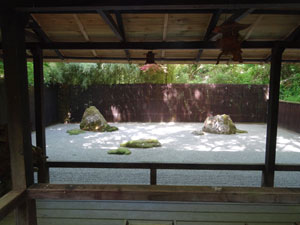
Commonly called a Zen garden, a Japanese rock garden is designed to suggest a miniature landscape, complete with mountains and rippling water, represented by carefully placed rocks and artistically raked gravel.
A dry Zen landscape may also compose a number of other important features, such as moss at the base of the rocks to symbolise land or and island. You may also see some pruned maples, pines and other bonsai-like trees, as well as evergreen shrubs clipped as ball shapes, with flowering satsuki azaleas (rhododendron indicum varieties) being a popular choice for this particular treatment.
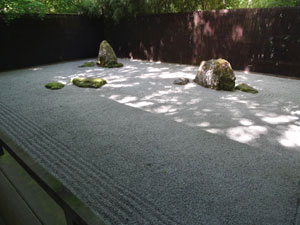
Buddhist History
The history of Zen gardens starts in the 14th century, at the Buddhist temples of Kyoto in Japan.
Today, they have evolved into an integral part of Japanese garden design, with careful attention being given to selecting only the most perfect of rocks, and arranging them in the very best way possible. This is not always an easy task, especially when large and extremely heavy stones are chosen for the grouping.
Arrangement of Rocks
It is best not to place the rocks in straight lines, as this can look very artificial and visually unbalanced. Also, if you are intending to group your stones, it is sensible to either arrange them in pairs, as a three, and above that, in odd numbers.
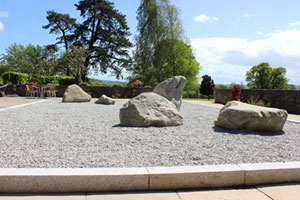
A group of four or six rocks can look very staged and unnatural. Zen gardens often have two or more groupings of rocks, with one prominent 'island' and a smaller, more distant gathering.
Each rock will have a best viewing angle, so take time to choose a 'front' for the stones. Imposing tall, vertical rocks suggest height and drama, especially when contrasted with shorter, flatter stones. Be sure to make your Zen garden arrangement harmonious, with similar coloured rocks where any visible markings do not dominate the scene.
If a stone has a streak of white showing on its surface, this can be used to represent a waterfall. Alternatively, rather than using rocks, you can instead used man-made granite pillars, spheres or squares, to create a more contemporary appearance, while fossilised tree stumps offer a convincing texture.
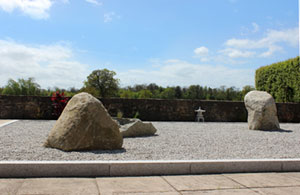
Gravel or Sand?
Gravel is most commonly placed around the base of the rocks in Zen gardens, being contained by a boundary of wood, paving or bamboo.
Sand may also be used, but is more likely to lose its raking pattern on rainy and windy days. There are many different ways to rake your gravel, with special bamboo rakes being used to create these distinctive patterns.
Most Japanese rock gardens feature gravel raked in circles around the rocks, to suggest a wave pattern or ridges, with the rest of the gravel being raked in contrasting neat straight lines or occasionally an abstract chequerboard pattern. When raking lines in the gravel, take care to work backwards so as not to leave any footsteps behind.
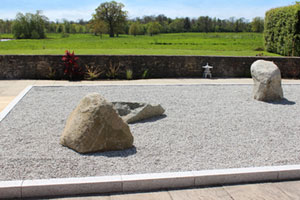
Space and Backgrounds
Simplicity is the key with Zen gardens and it is important to hold back, so as to keep the landscape uncluttered and minimalistic. The space should be quiet and peaceful, somewhere that you could happily meditate and take time out to fully appreciate the miniature scene and immerse yourself in nature, awakening your senses.
A neutral wall at the back and possibly the sides will help to frame the scene and allow the rocks to be more easily appreciated, isolated against the plain backdrop. A well-placed bench or two is an essential addition to any Zen garden, so that you have somewhere to sit and admire its beauty and symbolism.
 Commonly called a Zen garden, a Japanese rock garden is designed to suggest a miniature landscape, complete with mountains and rippling water, represented by carefully placed rocks and artistically raked gravel.
Commonly called a Zen garden, a Japanese rock garden is designed to suggest a miniature landscape, complete with mountains and rippling water, represented by carefully placed rocks and artistically raked gravel.
 A group of four or six rocks can look very staged and unnatural. Zen gardens often have two or more groupings of rocks, with one prominent 'island' and a smaller, more distant gathering.
A group of four or six rocks can look very staged and unnatural. Zen gardens often have two or more groupings of rocks, with one prominent 'island' and a smaller, more distant gathering.
